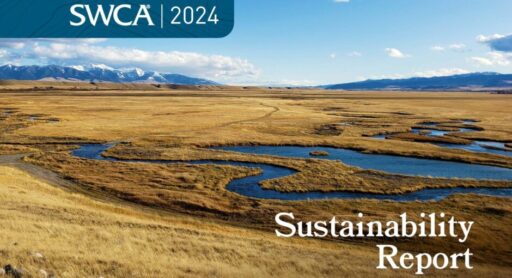2025
Comparably’s Best Company Outlook
* Providing engineering services in these locations through SWCA Environmental Consulting & Engineering, Inc., an affiliate of SWCA.

From the experts we hire, to the clients we partner with, our greatest opportunity for success lies in our ability to bring the best team together for every project.
That’s why:

At SWCA, sustainability means balancing humanity’s social, economic, and environmental needs to provide a healthy planet for future generations.
SWCA employs smart, talented, problem-solvers dedicated to our purpose of preserving natural and cultural resources for tomorrow while enabling projects that benefit people today.

At SWCA, you’re not just an employee. You’re an owner. Everyone you work with has a stake in your success, so your hard work pays off – for the clients, for the company, and for your retirement goals.
U.S. Army Corps of Engineers and U.S. Environmental Protection Agency Release Proposed Waters of the United States Rule
On November 18, 2021, the U.S. Army Corps of Engineers (USACE) and the U.S. Environmental Protection Agency (EPA) issued a proposed rule to define waters of the United States (2021 WOTUS Rule).
Russell has more than 25 years of experience in environmental regulations compliance for federal, state, and local laws with an understanding of the nuances of FERC regulations and NEPA, CWA, and ESA compliance.

Nathan Jones is a Principal Environmental Consultant who oversees and manages renewable energy development projects. His extensive experience includes supporting, permitting, and managing projects on federal, state, and private lands. Nathan is well-versed in regulatory frameworks such as FAST-41 (Title 41 of the Fixing America’s Surface Transportation (FAST) Act), NEPA, ESA, CWA, and NHPA, along with state and local regulations. Additionally, he offers technical assistance to other project managers in the renewable energy sector.

Weissman is a Senior Project Manager at SWCA with over 15 years in the environmental consulting industry. She is experienced in all phases of the environmental permitting process, including leading wetland and natural resource field assessments in both coastal and freshwater communities, preparing federal and state environmental permit applications, and coordinating with regulatory agencies. Ms. Weissman has a wide-breadth of project experience, including energy (wind, electric transmission, and natural gas), transportation, and retail and commercial development projects. Ms. Weissman’s technical background is in wetland science, and she is both a Professional Wetland Scientist (PWS) and New Hampshire Certified Wetland Scientist (CWS). She has conducted numerous wetland delineations and vernal pool assessments throughout the northeastern United States, and holds a Certificate in Native Plant Studies from the New England Wildflower Society. She is a vice-chair of the Holliston Conservation Commission and was previously a member of the Wellesley Wetlands Protection Committee.
Over the past 8 years, Ms. Weissman’s primary focus has been the management of natural gas pipeline projects regulated by the Federal Energy Regulatory Commission. Ms. Weissman has coordinated and managed numerous environmental permit applications submitted to FERC, the U.S. Army Corps of Engineers, and various state environmental agencies throughout the United States.




On November 18, 2021, the U.S. Army Corps of Engineers (USACE) and the U.S. Environmental Protection Agency (EPA) issued a proposed rule to define waters of the United States (2021 WOTUS Rule). The 2021 WOTUS Rule is similar in structure and approach as the pre-2015 regulations, which are described in the 2008 USACE and EPA memorandum titled Clean Water Act Jurisdiction Following the U.S. Supreme Court’s Decision in Rapanos v. United States & Carabell v. United States. Compared to the 2020 Navigable Waters Protection Rule (NWPR), the 2021 WOTUS Rule would result in potentially substantial differences in jurisdictional status including, but not limited to, the following.
Additionally, the 2021 WOTUS Rule would depart from some of the practices under the 2008 Agency Guidance, including:
The 2021 WOTUS Rule will be subject to public and interagency comment prior to finalization and implementation. SWCA recommends reviewing the proposed rule to identify potential concerns or benefits, attending virtual Public Hearings currently scheduled for January 12, 13, and 18, 2022, and submitting comments via Regulations.gov during future comment periods.
For updates or additional information, please reach out to your primary SWCA contact or one of our regional wetland leads:
Bonnie Rogers | West